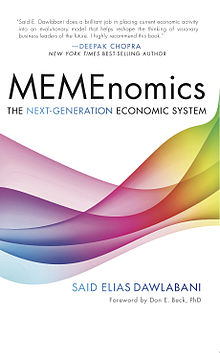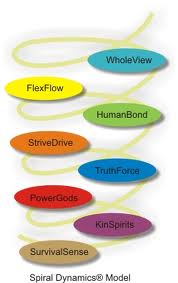TRANSLATE THIS ARTICLE
Integral World: Exploring Theories of Everything
An independent forum for a critical discussion of the integral philosophy of Ken Wilber
 Said E. Dawlabani is a Lebanese American cultural economist, author, theorist and consultant, specializing in macroeconomic memetic systems and cultural change based on the value-systems approach. Dawlabani is the COO and member of the Board of Directors of The Center for Human Emergence Middle East. He can be reached at [email protected]
MEMEnomics
An Evolutionary Journey
through Western Capitalism
Said Dawlabani
Today the US economy is entering the growth phase of the fourth MEMEnomics cycle, the Green value system.
MEMEnomics; The Next-Generation Economic System is a book that reframes the American experience of capitalism through an evolutionary lens. The book represents the culmination of ten years of work by author Said E. Dawlabani. He is an integrally informed cultural economist and a practitioner of Spiral Dynamics Integral. The framework represents a whole-systems, integrated model that places economic activity into an emergent values context. This is one of the first applications of the bio-psycho-social development model originally pioneered by psychologist Clare W. Graves to macroeconomic issues. MEMEnomics uses Graves' framework, the research of his successor Don Beck, and the author's in depth knowledge of finance and real estate to place the long-established field of economics into a values-based evolutionary model.
The book introduces the concept and the history of Grave's value systems. It starts in the eye of the storm of the 2008 financial crisis on the day former Federal Reserve Chairman, Alan Greenspan testified to the US Congress about the shortcomings that exposed vulnerabilities in the capitalist system over the last four decades. This becomes the catalyst that sparks the search for a new paradigm and sets the stage for the reader to understand that the Enlightenment Era, a part of Orange fifth level system of values, was just a stop along our journey of human emergence in an endless quest towards higher values.

The book offers details of the main principles behind the emerging science of value-systems on which the concept of MEMEnomics is built. It describes how cultures emerge and why and introduces Graves' research and the Spiral Dynamics theory, which represent the most ambitious effort on the mapping of human existence. There are many examples of different economic value systems around the world with analysis that demonstrate how the US and much of the West have been approaching economic development from “subsistence values” of the First Tier systems which sets forth the urgent need to alter our approach.
The framework introduces the concept of MEMEnomic Cycles that explain how visionary ideas are born and come to define our culture and how they mature, decline, and eventually decay, and become a part of the DNA of future cycles. The reader is provided with a fresh view on the role of technology and how it affects human emergence. The book also introduces new value system approaches on the nature of change, which enable the reader to distinguish between aesthetic change and systemic change and know when and how to design for each. Money is reintroduced as an agent of the values of temperance, (Blue fourth level value system) and a critical perspective is offered on the challenges facing not just the US but also other Western economies today. This time is indeed different, not just because of what economic research tells us, but because we have perverted the historic representative of productive output, Money. In the US it has been experimented with as an agent of the Orange value system, and in Europe as an agent of the Green value system.
The US has experienced three MEMEnomic Cycles since the end of its Civil War. These are the Red, Blue and Orange value systems respectively. After a value systems analysis of each cycle, the reader gains a deep understanding of how and why complex economic ideologies rise and fall and why the financial crisis of 2008 was the turning point for the transcendence of a lower value expression in order for the evolution of capitalism to continue on its endless quest along the upward spiral of human existence. Today the US economy is entering the growth phase of the fourth MEMEnomics cycle, the Green value system that overlaps with the entropy and decay phase of the third cycle, the Orange system. The former defined by the values that seek the democratization of resources, the latter by the values and economic ideologies that define everything through financial innovation.
MEMEnomics closely examines the virtues of the fourth cycle such as collaboration, peering, presencing, openness and sharing, which are the primary representatives of the post-industrial values. This is the emergence of egalitarianism and humanitarianism at the workplace and as a corporate philosophy. These are values that seek the deeper understanding of humanity and the role of capitalism in it. This stage of development is a necessary stepping-stone as the US economy works its way towards this higher level of communal values. This phase however, won't represent the Utopian happy ending for capitalism.

The last part of the book details the Platform for Functional Capitalism, which is a value-systems guide to an economy designed from the Yellow and Turquoise systems, or the Second Tier of values. These are the highest known levels of existence. They represent the values of a humanity empowered by big picture integration and acknowledge humanity's holistic interdependence. They espouse the “magnificence of existence” ethic that was described in Graves' original research. This is the emerging Fifth MEMEnomic Cycle that is in its embryonic and introductory phases in parts of the US, Northern Europe and Germany. As we move forward in time, this cycle will continue to differentiate its own memetic characteristics and build more complexity in response to existential challenges that are being brought on by the lasting effects of the Great Recession and the disruption of the knowledge economy.
- Adopting “functional” forms of management is a concept for large-scale change based on the unique cultural DNA codes of the Yellow seventh level of values. This is a system that aims to synthesize and integrate the best expression of past cycles into a functional flow while scanning the horizon for change. This is the distributed intelligence of biological systems being pioneered in economics. The first pillar of this new system is a smart government. While the values of governance in the past are represented by the 4th level Blue system, effective governance of the future has to be designed from the Yellow seventh level of values. Examples of political leaders in the US who exhibit these values are former Fed Chairman Paul Volker and Massachusetts Senator Elizabeth Warren. The next system of governance sees right through the incompetence of the current political system and its complicity with lobbyists and corporate interest.
- The second pillar of this platform is the creation of a functional financial system that provides a new understanding of money once it is redefined through its role as a catalyst for social emergence. The often-unseen problem with the field of financial innovation is that it has decoupled from any reasonable measure of productive output. A Yellow seventh-level system realigns finance with productivity and introduces an integrated monetary system that is more congruent with the proven functional history of money, yet still allows for an evolving expression of productive human output.
The MEMEnomics framework also examines the nature of central banking and the functional reforms needed in order to restore the Fed's role as the facilitator of distributed prosperity. It introduces new design elements in order to create Yellow seventh-level capital markets and details how to steer investment banking away from non-productive pursuits that remain the main cause behind every financial crisis.
- The third pillar for functional capitalism is the empowerment of manufacturing through Yellow seventh level values. This is Second Tier functionality in manufacturing based on a concept developed by Dr. Beck for South Africa called MeshWORKS. It calls on all the stakeholders to participate in its design. Everyone from teachers, community leaders, research universities, and a smart government must participate in its design. This guardian of middle and working class values is retuning to the US and it's looking nothing like it did when it left. It is digital and robotic. It is additive, modular and green and has all the marking of a third industrial revolution. It is coming to the garage of anyone who wants to participate. This is the distributed intelligence model of the factory of the future. It presents the US with the rare opportunity to design an entirely new and sustainable economic sector if it's approached from an ecosystems perspective of the Yellow seventh level of values.
- The fourth and final pillar of The Platform for Functional Capitalism is the reframing of corporate practices through the integrative values of the Yellow system. The evolution of the term “Ownership” is placed in the context of seventh level values. Systemic sustainability is examined through examples of Founder CEO's and is then compared to those of professional CEO's. Then an analysis reveals the core characteristics of a seventh-level CEO and what it takes to establish a seventh-level corporate culture. In the US today, there are two distinct types of seventh-level corporations that are redefining the future of capitalism. Google and the disruptive nature of the knowledge economy represent the first emerging model. Whole Foods and its conscious evolutionary concepts of the stakeholder model represent the second. An analysis is offered of the Conscious Capitalism Movement and why it holds the promise for the systemic spread of Yellow seventh-level values in business practices.
The MEMEnomics framework is based on the belief that whole-systems thinking is the way of the future, and by reframing economics through the lenses of the Yellow sevnth level value system we begin to see what that future looks like. As commerce emerges to higher values it has to shift to a paradigm that sees all its activities as a part of a living system that is holistically interdependent on a planet with finite resources.
References
MEMEnomics; The Next-Generation Economic System by Said Elias Dawlabani, foreword by Don E. Beck, PhD. (SelectBooks, Inc., Publishers, 2013). Available in hard cover or e-book at all book retailers or online.
|
 Said E. Dawlabani is a Lebanese American cultural economist, author, theorist and consultant, specializing in macroeconomic memetic systems and cultural change based on the value-systems approach. Dawlabani is the COO and member of the Board of Directors of The Center for Human Emergence Middle East. He can be reached at [email protected]
Said E. Dawlabani is a Lebanese American cultural economist, author, theorist and consultant, specializing in macroeconomic memetic systems and cultural change based on the value-systems approach. Dawlabani is the COO and member of the Board of Directors of The Center for Human Emergence Middle East. He can be reached at [email protected]

